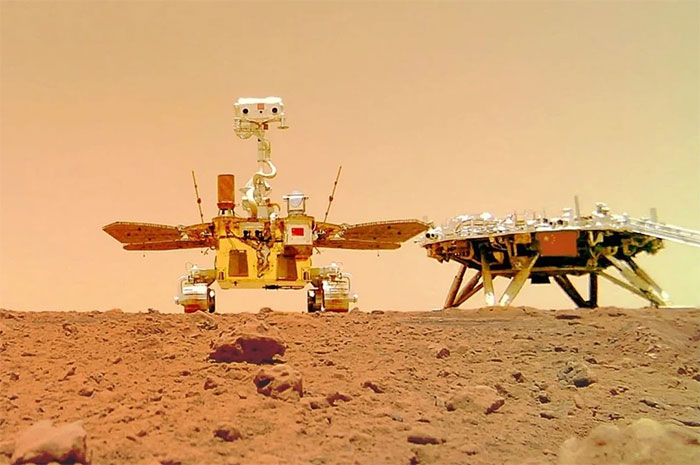China's Mars rock recovery mission went smoothly, NASA encountered difficulties
China will likely win against the US in the context of NASA having difficulty in its mission to retrieve samples from Mars.
According to SCMP, the cost of the Mars rock recovery program undertaken by NASA could exceed 10 billion USD , while China is likely to become the first country to do this.
This comment was made after a meeting held in Beijing (China) with updates on developments from the mission to collect rocks on Mars and bring them back to Earth.

Zhurong - China's first Mars exploration rover. (Photo: CNSA).
Sun Zezhou, chief designer of the Tianwen 1 (Tianwen-1) spacecraft, affirmed that China already has all the key technologies needed for the Tianwen 3 mission , and everything is progressing smoothly. .
It is known that the Thien Van 1 spacecraft helped China become the second country after the US to land softly on the Red Planet in 2021.
However, to date, no country has successfully taken samples from Mars. In that context, both the US and China are making efforts to become "leaders".
On the Chinese side, Sun Zezhou said the project's scientists are ready. They pointed out the two biggest challenges for the Thien Van 3 mission to succeed.
In particular, the first step is the process of collecting rock samples, then taking off from the surface of Mars. The next step is to return the capsule containing the sample back to Earth.
"All stages require our spacecraft to be extremely intelligent at the system design level ," Zezhou said.
According to this expert, China is increasingly likely to become the first country to successfully carry out a sample return mission on Mars , although the United States has a longer history of exploring the Red Planet. .
That's because for the US, things seem to be more complicated , as their Mars sample return mission (named MSR) has been continuously delayed. Along with that, the total cost of the mission has increased significantly from the initial $4 billion, potentially surpassing $10 billion.
In February, the Jet Propulsion Laboratory in Pasadena, California - the unit in charge of the MSR mission - laid off 8% of its staff. Along with that, the entire scientific mission of the unit may be subject to cost cuts by the US Congress, especially for the MSR project.
Despite the delays and uncertainty, scientists remain hopeful that the MSR program will be successful, as its sampling sites are diverse and carefully selected to provide high scientific value .
MSR is set to collect Martian rocks, which are currently being collected by NASA's Perseverance probe in Jezero Crater. They will then be returned to Earth expected around 2031.
Meanwhile, China's Tianwen 3 mission will likely complete its goal one year earlier, in 2030. In addition to Tianwen 3 and MSR, India and Europe will also soon launch missions with the same destination. is the Red Planet.
Specifically, the Mars Orbiter Mission 2 spacecraft (India) and ExoMars Rosalind Franklin (Europe) are expected to be launched in 2024 and 2028, although they are not designed to retrieve samples.
- NASA ships find gray stones on the surface of Mars
- NASA prepares a new mission on Mars
- NASA tested parachutes for the Mars mission,
- NASA's Mars mission was delayed for another 2 years
- NASA revealed the mission of the next Mars probe
- NASA robots detect precious clues about life on Mars
- NASA's Maven spacecraft approached Mars
- NASA is about to launch a ship to study the Martian atmosphere
- 'Message' from the fourth meteorite on Mars
- The Maven is about to enter Mars's orbit
- NASA launched the Mars probe
- NASA equipped lasers for Mars to explore Mars
 Announced 3 houses on the Moon and Mars
Announced 3 houses on the Moon and Mars Science proves: Mars also knows 'deflated'
Science proves: Mars also knows 'deflated' Elon Musk announced the price for a Mars trip was 11.6 billion VND, free of charge
Elon Musk announced the price for a Mars trip was 11.6 billion VND, free of charge NASA discovered strange 'gate' on Mars, is the hiding place found?
NASA discovered strange 'gate' on Mars, is the hiding place found?